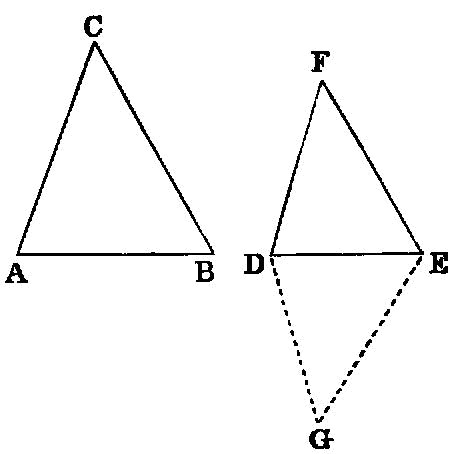Proposition 6.5

If two triangles have their sides proportional, the triangles will be equiangular and will have those angles equal which the corresponding sides subtend.
Let ABC, DEF be two triangles having their sides proportional, so that, as AB is to BC, so is DE to EF, as BC is to CA, so is EF to FD, and further, as BA is to AC, so is ED to DF; I say that the triangle ABC is equiangular with the triangle DEF, and they will have those angles equal which the corresponding sides subtend, namely the angle ABC to the angle DEF, the angle BCA to the angle EFD, and further the angle BAC to the angle EDF.
For on the straight line EF, and at the points E, F on it, let there be constructed the angle FEG equal to the angle ABC, and the angle EFG equal to the angle ACB; [I. 23]
Therefore the triangle ABC is equiangular with the triangle GEF.
Therefore in the triangles ABC, GEF the sides about the equal angles are proportional, and those are corresponding sides which subtend the equal angles; [VI. 4] therefore, as AB is to BC, so is GE to EF.
But, as AB is to BC, so by hypothesis is DE to EF; therefore, as DE is to EF, so is GE to EF. [V. 11]
Therefore each of the straight lines DE, GE has the same ratio to EF; therefore DE is equal to GE. [V. 9]
For the same reason DF is also equal to GF.
Since then DE is equal to EG, and EF is common, the two sides DE, EF are equal to the two sides GE, EF; and the base DF is equal to the base FG; therefore the angle DEF is equal to the angle GEF, [I. 8] and the triangle DEF is equal to the triangle GEF, and the remaining angles are equal to the remaining angles, namely those which the equal sides subtend. [I. 4]
Therefore the angle DFE is also equal to the angle GFE, and the angle EDF to the angle EGF.
And, since the angle FED is equal to the angle GEF, while the angle GEF is equal to the angle ABC, therefore the angle ABC is also equal to the angle DEF.
For the same reason the angle ACB is also equal to the angle DFE, and further, the angle at A to the angle at D; therefore the triangle ABC is equiangular with the triangle DEF.
Therefore etc. Q. E. D.
